|
Two-dimensional illustrations related to the
many-sheeted space-time concept
Matti Pitkänen (January 20, 2003)
Postal address:
Department of Physical Sciences, High Energy Physics Division, PL 64,
FIN-00014, University of Helsinki, Finland.
Home address:
Kadermonkatu 16, 10900, Hanko, Finland
E-mail:
matpitka@rock.helsinki.fi
URL-address:
http://www.physics.helsinki.fi/~matpitka
A. TGD based spacetime
concept
The starting point of TGD is the 'energy problem' of General
Relativity. By Noether's theorem, conservation laws are in one-one
correspondence with symmetries. In particular, translational invariance
of the empty Minkowski space M^4 implies energy and momentum
conservation in Special Relativity. By the basic postulate of General
Relativity matter makes spacetime curved. This means that the symmetries
of the empty Minkowski space are lost as are lost also the corresponding
conservation laws, in particular the conservation of energy.
The basic idea of TGD is to assume that spacetime is representable as
a surface of some higher dimensional space H=M^4xS and that
translational symmetries, and more generally, Poincare invariance
correspond to the symmetries of M^4-factor of this higher-dimensional
space rather than those of spacetime itself. Hence a fusion of Special
and General Relativities in a well defined sense is in question. In fact
mathematical and physical reasons force to replace empty Minkowski space
M^4 with its light cone M^4_+. Future light cone corresponds to empty
Robertson Walker cosmology and TGD inspired cosmology has subcritical
mass density as a consequence. There is small cosmological breaking of
Poincare invariance since M^4 is replaced by its lightcone.

Fig. 1. Matter makes spacetime curved and spoils translational
invariance. Two-dimensional illustration.
By physical constraints (elementary particle spectrum) the space S
must be CP_2, the complex projective space of two complex (four real)
dimensions. The size of CP_2 is about 10^4 Planck lengths (roughly
10^(-30) meters). [It took long time to realize that the original
assumption about size of order Planck length was not correct].

Fig. 2. Future light cone of Minkowski space.

Fig. 3. CP2 is obtained by identifying all points of C^3, space
having 3 complex dimensions, which differ by a complex scaling Lambda: z
is identified with Lambda*z.
CP2 can also be regarded as a coset space SU(3)/U(2),
U(2)=SU(2)xU(1). What this means is that one starts from the
8-dimensional group SU(3) of unitary 3x3 matrices of determinant one and
identifies all matrices which differ by a left multiplication by an
element of the 4-dimensional subgroup U(2). One can also say that each
point of SU(3) is obtained from CP2 by replacing each point of CP2 with
the group U(2). U(2) in turn can be regarded as S^3xS^1, that is as the
space obtained by replacing each 2-dimensional disk giving a cross
section of the ordinary torus (doughnut) with a 3-dimensional sphere
S^3. By this construction CP2 is so called symmetric space, whose all
points are equivalent metrically (like those of Euclidian space) and has
color group SU(3) as its group of distance preserving transformations,
isometries.

Fig. 4. H= M^4_+xCP_2 is obtained by replacing each point of the
future light cone with the 4-dimensional compact space CP_2 of size R of
order 10^4 Planck lengths (10^(-30) meters).
The second manner to end up with TGD is to start from the old
fashioned string model, which also served as a starting point of super
string models, which have been in fashion during the last ten years.
Mesons are strongly interacting particles and string model
description was in terms of a string with quark and antiquark attached
to the ends of the string. A problem was encountered in an attempt to
generalize this description to apply to baryons which consist of three
quarks. One cannot put 3 quarks to the ends of the string since it has
only two ends.
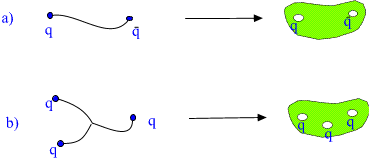
Fig. 5. The transition from hadronic string model to TGD.
The solution of the problem is simple. Replace one-dimensional
strings with small 3-dimensional surfaces. Since the ends of the string
correspond to the boundaries of a one-dimensional manifold they
correspond in 3-dimensional case boundaries of small holes drilled in
3-dimensional space. Put quarks on these boundaries. In 3-dimensional
case one can drill arbitrary number of these holes so that also baryons
can be described in this kind of model.
TGD based spacetime concept differs in many crucial aspects from the
conventional one. In the following this difference is visualized by
replacing 3-dimensional space (now surface in H) with two-dimensional
surface whereas 8-dimensional imbedding space is replaced with
3-dimensional slab of thickness of order 10^4 Planck lengths. This
simplification makes it possible to illustrate the most essential
aspects of the generalization easily and at least
geometrically/topologically oriented reader can guess the rest.
Below is a general view of what many-sheeted 3-space would look like
if it were 2-dimensional

Fig. 6. This is what 3-space would look if it were a 2-dimensional
surface in 3-dimensional slab of thickness of order 10^4 Planck lengths.
B. Elementary particles as 3-surfaces of size of order R=10^4
Planck lengths: CP2 extremals.
Elementary particles have geometric representation as so called CP2
type extremals. Instead of standard imbedding of CP2 as a surface of
M^4+xCP2 obtained by putting Minkowski coordinates m^k constant
m^k=const.,
one considers 'warped' imbedding
m^k =f^k(u) u is arbitrary function of CP2 coordinates with the
property that the M4_+ projection of the surface is random light like
curve:
mkl dm^k/du dm^l/du =0, mkl is flat M4 metric. (A)
The condition implies that induced metric is just CP2 metric, which
is Euclidian! The curve is random and therefore one has classical
nondetermism: this makes sense since the solution is vacuum extremal.
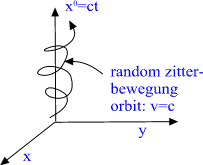
Fig. 7. The projection of CP2 type extremal to M4+ is lightlike
curve.
Elementary particles correspond to CP2 type extremals with holes: the
intersection of bound with m^0=const hyperplane is sphere, torus, sphere
with two handles, etc...: shortly a surface with genus g=0,1,2,... .
Different fermion families correspond to different genera. Bosons are
also predicted to have family replication phenomenon.

Fig. 8. Different fermion families correspond to different genera for
the boundary component of CP2 type extremal.
Feynmann diagrams correspond to topological sums of CP2 type
extremals: the lines of diagram being thickened to CP2 type extremals:

Fig. 9. Feynmann diagrams correspond to connected sums of CP2 type
extremals: each line of Feynmann diagram is thickened to CP2 type
extremal.
The quantum version of the condition (A) stating that the M4_+
projection is light like curve leads to Super Virasoro conditions and it
turns out that elementary particles together with their 10^(-4) Planck
mass excitations belong to representation of p-adic Super Virasoro and
Kac Moody. The p-adic mass calculations lead to excellent predictions
for particle masses.
C. Induced gauge field concept implies radical generalization of
spacetime concept
The concept of connection geometrizes the concept of the parallel
translation appearing already in elementary geometry. Parallel
translation can be performed for vectors, tensors, spinors,... In
Euclidian case parallel translation is just what one would imagine it to
be and the parallel translation around a closed curve brings the vector
back without any change in its direction. The formal definition of the
parallel translation along a geodesic line (the counterpart of a
straight line) in a more general context requires that the angle between
the vector and geodesic line is preserved. Sphere is a simple example of
a situation in which parallel translation around a closed curve changes
the direction of the vector. One says that sphere is curved and
curvature is locally measured by the amount of change in the direction
of a vector for very small geodesic triangle. 
Fig. 10. Parallel translation on sphere and on plane.
In General Relativity, the so called Riemann connection defining the
parallel translation in spacetime leads to a beautiful geometrization of
the gravitational interaction. The presence of matter makes spacetime
curved and geodesics are not straight lines anymore. The advent of the
gauge theories led to a partial geometrization of the boson fields. The
components of the gauge potentials can be regarded as components of a
connection defining parallel translation formally.
The problem is however that there is not direct geometric
interpretation for this parallel translation and here TGD provides the
final geometrization of classical gauge field concept. The components of
electroweak gauge potentials are obtained as projections of the spinor
connection of CP2 to spacetime surface:
Amu = A_k partialmu h^k
(mu is the coordinate index for spacetime coordinates, k for imbedding
space coordinates)
or geometrically; parallel translation on spacetime surface is
performed using spinor connection of the imbedding space.

Fig. 11. Classical electroweak gauge potentials at spacetime surface
are obtained as projections of the components of CP2 spinor connection.
Classical color gauge potentials are identified as projections of
Killing vector fields of su(3) to spacetime surface (very much like in
Kaluza-Klein theories). The requirement that standard model electroweak
gauge group allows only M^4_+xCP2 as imbedding space. Also standard
model quantum numbers are geometrized in terms of CP2 geometry and
topology of the boundary component of CP2 type extremal. The special
features of CP2, in particular the fact that it does not allow standard
spinor structure, are crucial for obtaining the coupling structure of
standard model.
The induced gauge field concept differs from the ordinary one. The
PRIMARY dynamical variables are the four CP2 coordinates and this
implies strong constraints among classical gauge fields: for instance
classical electric field is often accompanied by classical Z0 field even
in macroscopic length scales.
There is rather precise metaphor making possible to understand the
concept of induced gauge field intuitively. The shadow (projection!) of
a nondynamical solid object ( < --> metric and spinor
connection of H) with time-independent size and shape to a surface
(<--> 3-surface) changing its size and shape is dynamical .

Fig. 12. Classical electroweak gauge potentials at spacetime surface
are obtained as projections of the components of CP2 spinor connection.
Even more importantly: gauge potentials are determined by the image
of map
X^4--> CP2
whereas ordinary gauge potentials are determined by the map
X^4 --> TM^4,
where TM^4 is the space of field values at given point of spacetime
and isomorphic to tangent space of M4. CP2 is COMPACT whereas TM^4 is
NONCOMPACT: a crucial difference!
This implies that general electromagnetic gauge potentials are
imbeddable only in some open region surrounding given point of spacetime
and that the imbeddability fails at the boundary of this region.

Fig. 13. The Maxwell field associated with a given charge
distribution is representable as induced gauge field only in a finite
region of spacetime. This implies the presence of boundaries.
Two-dimensional illustration.
The failure of imbeddability leads to generation of spacetime
BOUNDARIES in all lengths scales. At the boundary spacetime simply ends.
There is following problem on the boundaries: Kähler electric gauge
flux must be conserved on the boundary. Since the 3-space ends at
boundary there is no other manner to cope with situation than to
introduce second, larger, spacetime sheet parallel to the first one and
allow the gauge flux to run on this spacetime sheet via tiny wormholes
connecting the two sheets. Wormhole is constructed by drilling tiny
spherical holes inside the two parallel spacetime sheets and connecting
the boundaries S^2 of the holes with a cylinder S^2 xI having two ends
with S^2 topology. The figure below illustrates the situation if 3-space
were two-dimensional.
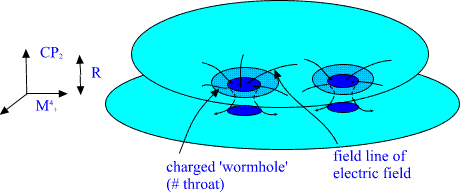
Fig. 14. Charged wormholes feed the electromagnetic gauge flux to the
'lower' spacetime sheet.
By adding these wormholes on the boundary of 3-surfaces the gauge
flux can flow to the lower spacetime sheet. An interesting possibility
is that wormholes are itself slightly deformed pieces of CP2 type
extremals.
The throats of wormhole behave as classical charges -Q and Q , where
Q is the electric gauge flux flowing to the wormhole at upper spacetime
sheet and out of it at lower spacetime sheet. Thus they serve as
currents and sources (of opposite sign) of classical gauge fields at the
two spacetime sheets.
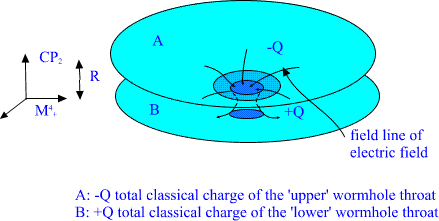
Fig. 15. The two throats of wormhole behave as classical charges of
opposite sign.
Wormholes couple to the DIFFERENCE OF CLASSICAL GAUGE POTENTIALS
associated with the two spacetime sheets since the classical charges are
opposite.
It seems safe to assume that photons (the extremely small CP2 type
extremals!) see wormholes from wider perspective that is extremely small
dipoles formed by the throats. The distance between charges is of order
10^4 Planck lengths and the direction of dipole is transversal to
spacetime surface so that polarization vector has very small projection
in M^4, where polarization vector of photon is. Thus the coupling to
photons should be negligible (dipole moment satisfies p > Q*R, R the
size of CP_2, and thus also dissipation effects.

Fig. 16. As for as coupling to photons is considered wormoholes are
expected to behave as extremely tiny dipoles.
This suggests very stronly that wormholes behaves much like
conduction electrons and are thus localized to the boundaries of spatime
surface. If wormholes are light (as they turn out to be) they obey
d'Alembert type equation and there is large energy gap between ground
state and excited states. Thus wormholes become suffer BE condensation
to ground state: charged wormholes behave thus much like
super-conductors.
Wormholes can have several topologies: in general one can drill holes
of genus g (sphere, torus, etc...) on two spacetime sheets and connect
them using cylinder I+genus g surface. In this they resemble ordinary
elementary particles which have also several genera (family replication
phenomenon).
The gauge flux conservation problem is encountered also in the lower
spacetime sheet and one must introduce third, fourth, etc. spacetime
sheet and in general one has hierarchy of spacetime sheets with
increasing sizes.

Fig. 17. Many sheeted spacetime structure results from the
requirement of gauge flux conservation.
The conclusion is that induced gauge field concept leads unavoidably
to the concept of many sheeted spacetime. This has radical consequences
for the structure of physical theory: one must replace thermodynamics,
hydrodynamics, etc with a hierachy of dynamics of various types, one for
each spacetime sheet in the hierarchy. This replacement must be
performed in ALL length scales.
D. Matter as topology
Since many sheetedness is encountered in all length scales a very
attractive manner to reinterpret our visual experience about world
suggests itself. Material objects having macroscopic boundaries
correspond actually to sheets of 3-space and 3-space literally ends at
the boundary of object. The 3-space outside the object corresponds to
the 'lower' spacetime sheet. Actually we can see this wild 3-topology
every moment!! The following 2-dimensional illustration should make
clear what the generalization really means.
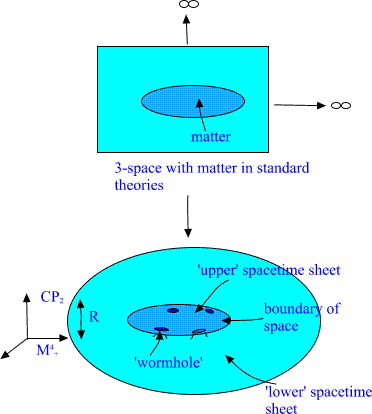
Fig. 18. Matter as topology
E. Join along boundaries contacts and join along boundaries
condensate
The receipe for constructing many-sheeted 3-space is simple. Take
3-surfaces with boundaries, glue them by topological sum to larger
3-surfaces, glue these 3-surfaces in turn on even larger 3-surfaces,
etc.. The smallest 3-surfaces correspond to CP2 type extremals that is
elementary particles and they are at the top of hierachy. In this manner
You get quarks, hadrons, nuclei, atoms, molecules,... cells, organs,
..., stars, ..,galaxies, etc...
Besides this one can also glue different 3-surfaces together by tubes
connecting their BOUNDARIES : this is just connected sum operation for
boundaries. Take disks D^2 on the boundaries of two objects and connect
these disks by cylinder D^2xD1 having D^2:s as its ends. Or more
concretely: let the two 3-surfaces just touch each other.

Fig. 19. Join along boundaries bond a): in two dimensions and b): in
3-dimensions for solid balls.
Depending on the scale join along boundariers bonds are identified as
color flux tubes connecting quarks, bonds giving rise to strong binding
between nucleons inside nuclei, bonds connecting neutrons inside neutron
star, chemical bonds between atoms and molecules, gap junctions
connecting cells, the bond which is formed when You touch table with
Your finger, etc.
One can construct from a group of nearby disjoint 3-surfaces so
called join along boundaries condensate by allowing them to touch each
other here and there.
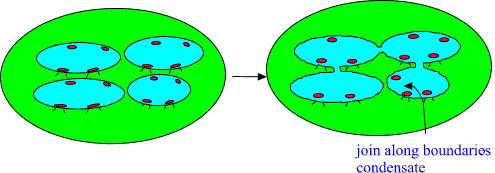
Fig. 20. Join along boundaries condensate in 2 dimensions.
The formation of join along boundaries condensates creates clearly
strong correlation between two quantum systems and it is assumed that
the formation of join along boundaries condensate is necessary
prequisite for the formation of MACROSCOPIC QUANTUM SYSTEMS.
F. p-Adic numbers and vacuum degeneracy
p-Adic length scale hypothesis derives from the analogy between SPIN
GLASS and TGD. Kähler action allows enormous VACUUM DEGENERACY: ANY
spacetime surface, which belongs to M^4_+xY^2, where Y^2 is so called
Legendre submanifold of CP2 is vacuum due to the vanishing of induced Kähler
form (recall that Kähler action is just Maxwell action for induced Kähler
form which can be regarded as U(1) gauge field).
Legendre submanifolds can be written in the canonical coordinates P^i,Q^i,
i=1,2 for CP2 as
P^i =f^i(Q^1,Q^2)
f^i =partial_i f(Q^1,Q^2)
where partial_i means partial derivative with respect to Q^i. f is
arbitrary function of Q^i! Legendre submanifolds are 2-dimensional. The
topology of vacuum space time is restricted only by the imbeddability
requirement. Vacuum spacetimes can have also finite extend in time
direction(!!): charge conservation does not force infinite duration.

Fig. 21. Vacuum extremals can have finite time duration.
This enormous vacuum degeneracy resembles the infinite ground state
degeneracy of spin glasses. In case of spin glasses the space of free
energy minima obeys ultrametric topology. This raises the question
whether the effective topology of the real spacetime sheets could be
also ultrametric in some length scale range so that the distance
function would satisfy
d(x,y) <= Max(d(x),d(y)) rather than d(x)+d(y)
p-Adic topologies are ultrametric and there is p-adic topology for
each prime p=2,3,5,7,... The classical non-determinism of the vacuum
extremals implies also classical non-determinism of field equations (but
not complete randomness of course).
p-Adic differential equations are also inherently non-deterministic.
This suggests that the non-determinism of Kähler action is effectively
like p-adic non-determinism in some length scale range, so that that the
topology of the real space-time sheet is effectively p-adic for some
value p. The lower cutoff length scale could be CP_2 length scale. Of
course, cutoff length scales could be dynamical.
Standard representation of p-adic number is defined as generalization
of decimal expansion
x= SUM_(n>=n0) x_np^n
p-Adic norm reads as
N(x)_p = p^(-n0) ,
and clearly depends on the lowest pinary digit only and is thus very
rough: for reals norm is same only for x and -x. Note that integers
which are infinite as real numbers are finite as p-adic numbers: p-adic
norm of any integer is at most one.
Essential element is the so called CANONICAL CORRESPONDENCE between
p-adics and reals
p-Adic number
x= SUM_(n>=n0) x_np^n
is mapped
to real number
y = SUM_(n>=n0) x_np^(-n)
Note that only the signs of powers of p are changed.
Second natural correspondence between p-adics and reals is based on
the fact that both reals and p-adics are completions of rational
numbers. Hence rational numbers can be regarded as common to both p-adic
and real numbers. This defines a correspondence in the set of rationals.
Allowing algebraic extensions of p-adic numbers, one can regard also
algebraic numbers as common to reals and algebraic extensions of p-adics.
p-Adic and real transcendentals do not have anything in common. Note
that rationals have pinary expansion in powers of p, which becomes
periodic for high pinary digits (predictability) whereas transcendentals
have non-periodic pinary expansions (non-predictability). One could say
that the numbers common to reals and p-adics are like islands of order
in the middle of real and p-adic seas of chaos. Both correspondences are
important in the recent formulation of p-adic physics.
G. p-Adic length scale hypothesis
p-Adic mass calculations force to conclude that the length scale
below which p-adic effective topology is satisfied is given
L_p simeq R*sqrt(p), R= 10^4*sqrt(G) (CP_2 length scale).
('simeq' means 'in good approximation'). One has also good reasons to
guess that p-Adic effective topology makes sense only above CP_2 length
scale. One can also define n-ary p-adic length scales
L_p(n) =p^((n-1)/2)L_p
It is very natural to assume that the spacetime sheets of increasing
size have typical sizes not too much larger than L_p(n). The following
figure illustrates the situation.
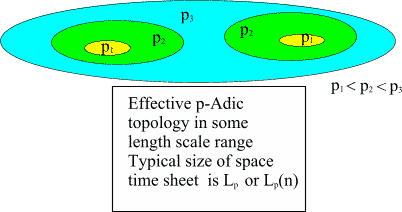
Fig. 22. p-Adic length scale hierarchy
The obvious question is 'Are there some physically favoured p-adic
primes?'. p-Adic mass calculations encourage the following hypothesis
The most interesting p-adic primes p correspond to primes near prime
powers of two
p simeq 2^k, k prime
Especially important are physically Mersenne primes M(k) for which
this condition is optimally satisfied p= 2^k-1 Examples: M(127)= 2^127
-1, M(107) = 2^107 -1, M(89)= 2^89 -1: electron, hadrons, intermediate
gauge bosons.
A real mathematical justification for this hypothesis is still
lacking: probably the p-adic dynamics depends sensitively of p and this
selects certain p-adic primes via some kind of 'natural selection'.
H. Generalization of spacetime concept
One can wonder whether p-adic topology is only an effective topology
or whether one could speak about a decomposition of the space-time
surface to real and genuinely p-adic regions, and what might be the
interpretation of the p-adic regions (note that also real space-time
regions would still be characterized by some prime characterizing their
effective topology).
The development of TGD inspired theory of consciousness led finally
to what seems to be a definite answer to this question. p-Adic physics
is physics of cognition and intention. p-Adic non-determinism is the
classical space-time correlate for the non-determinism of imagination
and cognition. p-Adic spacetime sheets represent intentions and quantum
jump in which p-adic space-time sheet is transformed to real one can be
seen as a transformation of intention to action.
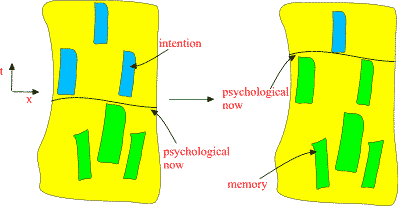
This forces to generalize the notion of the imbedding space. The
basic idea is that rational numbers are in a well-defined sense common
to both real number field R and all p-adic number fields R_p. The
generalized imbedding space results when the real H and all p-adic
versions H_p of the imbedding space are glued together along rational
points. One can visualize real and p-adic imbedding spaces as planes,
which intersect along a common axis representing rational points of H.
Real and p-adic spacetime region are glued together along the boundaries
of the real spacetime sheet at rational points.
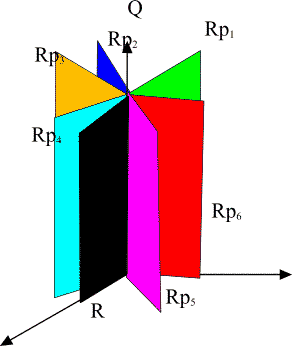
Generalized imbedding space is union of all p-adic imbedding
spaces H_p and real imbedding space H intersecting along rational points common
to all (Q denotes rationals, R for reals, and R_p for p-adic numbers). In figure
some of the imbedding spaces H_p are illustrated as half-planes.
The construction of p-adic quantum physics and the fusion of real
physics and p-adic physics for various primes to a larger scheme is
quite a fascinating challenge. For instance, a new number theoretic view
about information emerges. p-Adic entropy can be negative, which means
that system carries genuine information rather than entropy.
Additional Illustrations
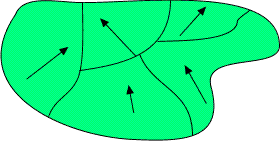
Spin Glass

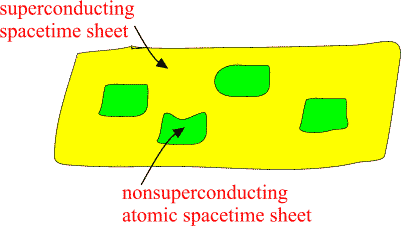
Atomic spacetime sheets are at high temperature and non-superconducting
as standard physics predicts but larger spacetime sheets can have very low
temperature and superconduct.
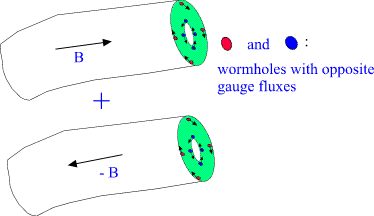
|
